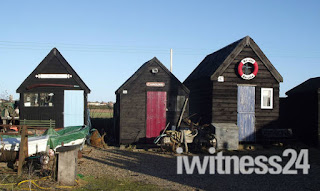Amongst the list of the blogs which I take a gander at from time to time there are, or used to be until I grew tired of them, a couple which ask terribly deep and meaningful questions about one's attitude to modelmaking, life, the Universe and everything. The answer as we all know is 42, so goodbye and thanks for all the fish.
No, no, can't we have a few of our own? One occurred to me today whilst idling a couple of hours away on Lantern Yard's substructure (the bit the meeces made lunch of).
Sonnie Boy's workshop
How should we approach the landscape which is the main feature of our model railways. Or our model set-pieces, if, like me, you don't actually need a railway to make scenery. I have put a small rail section in Lantern Yard, only because I made masters of O9 railway locos and wagons so I need somewhere to display them. But it doesn't need it, because it displays an earlier form of transport...or use of the landscape, if you like. It has a canal. A wharf and a lock. These would predate the little 18" gauge railway by at least 175 years astonishingly.
So, I got to thinking .....build the landscape, then plant it, then build ON it. Only in that way can the eventual model have a sense of authenticity. No good putting a railway down, then building a landscape around it and buildings by it.
I suppose one could make a case for building INTO the planting, yes, there will be some of that on Lantern Yard, where the blacksmith just couldn't resist the sale of an old Nissen hut after the War, but had to dig out a fair chunk of hill behind him. He did it, but was to be troubled by damp ever after, partly through too close a proximity to the digging and partly through the entirely predictable lack of sufficient drainage, but he would NOT be warned while the euphoria of acquisition was upon him and planning permission was negligible in those days and in those rustic parts.
So, this is the state of play at Lantern Yard. A justifiable small cottage and workshop for the blacksmith, a small wooden cafe with a brick extension for his wife to run and then the irresistible Nissen hut sections, which finally....... finally, he could use to set his son up as a mechanic and get him out of his hair. He'd tried to get him a job on the boats, or even the railway, but he was warned that the boats had maybe 10 years if they were lucky and the railway couldn't sustain a full time mechanic.
The blacksmith's cottage, NOT in its final spot
Sonnie Boy had got himself quite a reputation as an expert in the strange little (mainly) German three-wheelers that were getting people mobile since the War and he could fit a couple in at a time to repair, do up and even, occasionally, sell. As long as he didn't touch the canal boats, their engines and very occasionally their horses' hooves, a certain peace existed between father and son. The old man even tolerated the railway, because its presence ensured some future for the wharf.
More of Lantern Yard as it happens. A kind of Little Lake Woebegone in the Marcher country.















